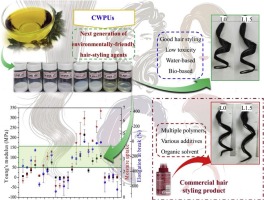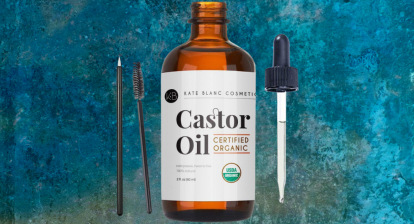The widespread use of hair-styling products raises an environmental concern due to the multiple components commonly used in their formulation, such as polyvinylpyrrolidone and its copolymers with vinyl acetate and maleic anhydride, as well as alcohol and ether polymers, and various additives [1], which can lead to health risks and environmental pollution during their synthesis. Therefore, a green hair-styling spray product with simple composition and environmentally-friendly characteristics is of great interest.
Polyurethanes have been extensively applied in coatings, adhesives, sealants, foams, and biomedical devices by virtue of their excellent molecular tailor-ability, abrasion resistance, high toughness, chemical resistance, good biocompatibility, and controllable degradation properties [[2], [3], [4]]. However, traditional polyurethane products usually contain large amounts of volatile organic compounds (VOCs). These VOCs are easily released into the environment during production and application, which leads to a big health and environmental threat [5]. Based on environmental and public health security needs, environmentally-friendly waterborne polyurethanes have received increasing attention at a global scale, and have been widely used in many fields such as ink, adhesives and coatings, aiming at reducing VOCs emissions [[6], [7], [8], [9]]. Kang et al. found that waterborne polyurethanes are promising materials for developing strong, long-lasting styling products with natural feel. They also pointed out that naturally occurring, renewable fatty acids from vegetable oils with versatile structures are effective emollient additives. However, the free fatty acids macromolecules easily migrated from the polyurethane matrix, which would affect the hair-styling performance of waterborne polyurethane based hair-styling agents [1].
To date, most of the starting materials used in the polyurethane industry (diisocyanates, polyols, and chain extenders) are petro–based chemicals, which are widely regarded as an environmental concern and a major source of air pollutants [10]. In addition, the fluctuation of crude oil price and the depletion of the world crude oil stock have triggered increasing interest in the development of sustainable polymers from renewable resources. Therefore, renewable alternatives suitable for recycling or biodegradation as a partial or complete replacement of petro-based starting materials have been reported [5,[11], [12], [13], [14], [15], [16], [17], [18], [19], [20], [21], [22], [23], [24], [25]]. In that context, vegetable oils are proved to be a promising platform to develop various bio-based polymers. For example, vegetable oil-based waterborne polyurethanes have also demonstrated tunable properties and excellent biocompatibility, which are promising characteristics for ink, adhesives, coatings, and biomedical devices [26].
In this work, bio-based waterborne polyurethanes are reported for the first time to be used in a hair-styling product. A series of castor oil-based waterborne polyurethanes (CWPUs) were successfully prepared from castor oil 164 (CO164, OH number: 164 mg KOH/g) and its derivative-castor oil 208 (CO208, OH number: 208 mg KOH/g) with dimethylol propionic acid (DP), dimethylol butanoic acid (DB), and N-methyl diethanolamine (MD) as chain extenders (Scheme 1). The samples are denoted as PUCn-x, where C is the chain extender used in CWPU, n is the OH number of castor oil, and x represents the molar ratio of the chain extender (Table 1). A good hair-styling material should be flexible without easily breaking, and it must not absorb moisture or become sticky. Therefore, the effects of the castor oil functionality and chain extender structure on the mechanical properties and the moisture uptake of the CWPUs were systematically investigated. Hair-styling performance and skin irritation tests on animals were also carefully performed to assess styling performance and safety of these CWPUs. These environmentally-friendly, bio-based CWPUs with strong styling performance and low toxicity will potentially be a new generation of hair-styling agent.




